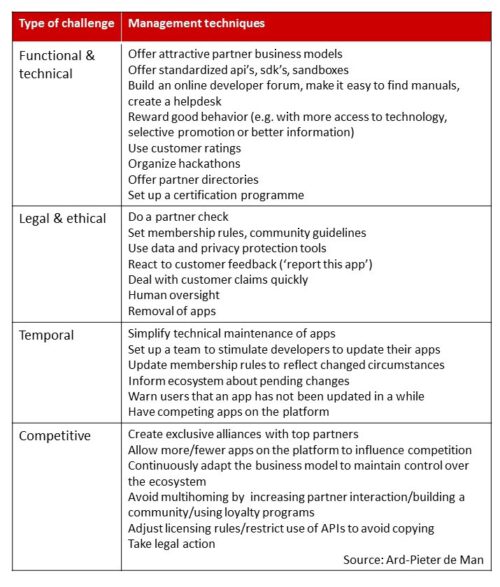Platform ecosystems (3): How to curate your platform ecosystem
This is part three of seven blogs on platform ecosystems. All blogs can be found on Blogs – Organizational Revolution
Partner ecosystem curation refers to the processes you need to select, to care for and to disengage with parties working on your platform. A thorough curation process is necessary to overcome the challenges that come with platform ecosystems. In blog 2 in this series I identified four such challenges: functional & technical challenges, legal & ethical challenges, temporal challenges and competitive challenges. As Alan Michaels said in his response to that previous blog, managing ecosystems is a huge and complex topic. It took me quite some reading, talking to people and thinking to identify and define these four challenges.
But the real hard work is in dealing with them. None of the challenges can be adequately dealt with by a few simple solutions. A clear and well-thought out policy of partner ecosystem curation is required.
In the table below I give an overview of two dozen techniques companies use to curate their ecosystem. This is not the place to run through all of them but at least note the following main points:
- Some techniques affect more challenges. A thorough check on partners before you let them into your ecosystem and onto your platform will help to address several challenges. When implementing one of the techniques, think about how this may affect the other challenges, positively or negatively.
- Each technique comes at a price. Take the example of the partner check. A thorough partner check will slow down your ability to scale, because it takes time to check partners. Think about the cost/benefit ratio of using each technique.
- Mix of rewards and punishment. Ecosystem curation means rewarding the good, but also punishing the bad. The punishments can be hard (expulsion from the platform) or soft (a little nudge to use the latest software update). Punishments may undermine relationships with partners, but letting partners get away with misbehaviour undermines the quality of the platform. You may have to be a benevolent dictator.
- High level of online work. Much curating can take place using online mechanisms. Digital technology makes it possible to monitor substantial amounts of business partners on your platform. Before setting up your ecosystem, think about what information you need to monitor partners and what information helps to keep them happy.
- Obviously companies don’t have to implement all mechanisms. The right balance is determined by how open or closed you want your ecosystem to be. In one of my later blogs I will deal with that topic.
Now here are the techniques for platform ecosystem curation, let me know if I missed any:

About this series
In a series of seven blogs I give my view on the ins and outs of managing platform ecosystems. I will discuss the four challenges of managing platform ecosystems, what companies do to overcome the challenges, a model for the governance of platform ecosystems, modelling ecosystems through value maps, how value proposition based ecosystems relate to platform ecosystems and when to opt for a closed or open ecosystem.
